| |
|
Xiamen Oil Paintings, Wholesale Direct!
|
|
100% hand painted, 100% cotton canvas, 100% money back if not satisfaction. |
|
|
|
|
ART WORKS INDEX
A
B
C
D
E
F
G
H
I
J
K
L
M
N
O
P
Q
R
S
T
U
V
W
X
Y
Z
|
|
ARTISTS INDEX
A
B
C
D
E
F
G
H
I
J
K
L
M
N
O
P
Q
R
S
T
U
V
W
X
Y
Z
|
|
|
|
|
|
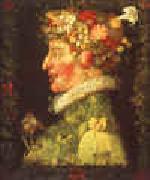 |
Giuseppe Arcimboldo
|
|
b.c. 1527, Milan,
d.1593, Milan Italian Giuseppe Arcimboldo Galleries
Arcimboldo was born in Milan in 1527, the son of Biagio, a painter who did work for the office of the Fabbrica in the Duomo.Arcimboldo was commissioned to do stained glass window designs beginning in 1549, including the Stories of St. Catherine of Alexandria vitrage at the Duomo. In 1556 he worked with Giuseppe Meda on frescoes for the Cathedral of Monza. In 1558, he drew the cartoon for a large tapestry of the Dormition of the Virgin Mary, which still hangs in the Como Cathedral today.
In 1562 he became court portraitist to Ferdinand I at the Habsburg court in Vienna, and later, to Maximilian II and his son Rudolf II at the court in Prague. He was also the court decorator and costume designer. King Augustus of Saxony, who visited Vienna in 1570 and 1573, saw Arcimboldo's work and commissioned a copy of his "The Four Seasons" which incorporates his own monarchic symbols.
Arcimboldo's conventional work, on traditional religious subjects, has fallen into oblivion, but his portraits of human heads made up of vegetables, fruit and tree roots, were greatly admired by his contemporaries and remain a source of fascination today. Art critics debate whether these paintings were whimsical or the product of a deranged mind.. A majority of scholars hold to the view, however, that given the Renaissance fascination with riddles, puzzles, and the bizarre (see, for example, the grotesque heads of Leonardo da Vinci, a fellow Milanese), Arcimboldo, far from being mentally imbalanced, catered to the taste of his times.
Arcimboldo died in Milan, to which he retired after leaving the Habsburg service. It was during this last phase of his career that he produced the composite portrait of Rudolph II (see above), as well as his self-portrait as the Four Seasons. His Italian contemporaries honored him with poetry and manuscripts celebrating his illustrious career. His hidden-face still-lives are a possible influence on his younger Lombard contemporary Caravaggio, whose painting of fruit in the Brera museum in Milan ranks as one of the earliest independent still-lives.
When the Swedish army invaded Prague in 1648, during the Thirty Years' War, many of Arcimboldo's paintings were taken from Rudolf II's collection.
His works can be found in Vienna's Kunsthistorisches Museum and the Habsburg Schloss Ambras in Innsbruck, the Louvre in Paris, as well as numerous museums in Sweden. In Italy, his work is in Cremona, Brescia, and the Uffizi Gallery in Florence. The Wadsworth Atheneum in Hartford, Connecticut, the Denver Art Museum in Denver, Colorado, the Menil Foundation in Houston, Texas, and the Candie Museum in Guernsey also own paintings by Archimboldo.
|
|
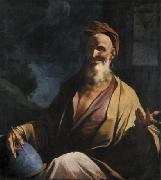 |
Giuseppe Antonio Petrini
|
|
(October 23, 1677- c. 1755-9) was a painter of the late-Baroque, active mainly in Lugano, present-day Switzerland.
St. Andrew
City Museum of Rimini, ItalyWhile born in Carona in Canton Ticino and died in Lugano, both in Switzerland, Petrini belongs to the Northern Italian or Lombard heritage of baroque painting. He possibly apprenticed with Bartolomeo Guidobono after 1700. While some works can be found in Como and Bergamo, most are located in Lugano and the surrounding area. He is also listed between 1711 and 1753 as fabbriciere of the church of Madonna deOnegro in Carona. He often painted "portraits" of historical figures including saints, philosophers, and scientists for patrons. One of his more prominent examples is his depiction of an auster St. Peter emerging from the shadows to pinpoint some lines in the gospel. He painted another St. Peter for the parish church of Dubino. Pietro Ligari classified him among the speculative painters, since these portraits, by nature, were imagined.
|
|
 |
Giuseppe Abbati
|
|
Italian, 1836-1868
Abbati was born in Naples and received early training in painting from his brother Vincenzo. He participated in Garibaldi 1860 campaign, suffering the loss of his right eye at the Battle of Capua. Afterwards he moved to Florence where, at the Caffe Michelangiolo, he met Giovanni Fattori, Silvestro Lega, and the rest of the artists who would soon be dubbed the Macchiaioli.
While his early paintings were interiors, he quickly became attracted to the practice of painting landscapes en plein air. His activity as a painter was interrupted during 1866 when he enlisted again in the army for the Third Independence War, during which he was captured by the Austrians and held in Croatia.
Returning to civilian life at the end of the year, he moved to Castelnuovo della Misericordia and spent the final year of his life painting in the countryside. Abbati died at the age of thirty-two in Florence after his own dog bit him, infecting him with rabies.
Giuseppe Abbati, The Tower of the Palazzo del Podesta, 1865, oil on wood, 39 x 32 cm.His paintings are characterized by a bold treatment of light effects. He often painted a luminous landscape scene as seen through the doorway of a darkened interior, as in the View from the Wine Cellar of Diego Martelli (1866). Some of his late landscapes are in the greatly elongated horizontal format often favored by the Macchiaioli.
|
|
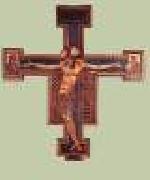 |
GIUNTA PISANO
|
|
Italian painter, Pisan school (active c. 1229-c. 1254 in Pisa).
|
|
|
|
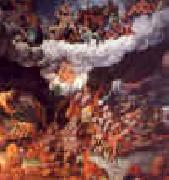 |
Giulio Romano
|
|
Italian
1492-1546
Giulio Romano was born in Rome. In his native city, as a young assistant in Raphael's studio, he worked on the frescos in the Vatican loggias to designs by Raphael and in Raphael's Stanze in the Vatican painted a group of figures in the Fire in the Borgo (L'incendio di Borgo) fresco. He also collaborated on the decoration of the ceiling of the Villa Farnesina. After the death of Raphael in 1520, he helped complete the Vatican frescoes of the life of Constantine as well as Raphael's Coronation of the Virgin and the Transfiguration in the Vatican. In Rome, Giulio decorated the Villa Madama for Cardinal Giuliano de' Medici, afterwards Clement VII. The crowded Giulio Romano frescoes lack the stately and serene simplicity of his master.
In the Palazzo Te, MantuaAfter the Sack of Rome in 1527 and the death of Leo X, artistic patronage in Rome slackened. Vasari tells how Baldassare Castiglione was delegated by Federico Gonzaga to procure Giulio to execute paintings and architectural and engineering projects for the duchy of Mantua. His masterpiece of architecture and fresco painting in that city is the suburban Palazzo Te, with its famous illusionistic frescos (c. 1525?C1535). He also helped rebuild the ducal palace in Mantua, reconstructed the cathedral, and designed the nearby Church of San Benedetto. Sections of Mantua that had been flood-prone were refurbished under Giulio's direction, and the duke's patronage and friendship never faltered: Giulio's annual income amounted to more than 1000 ducats. His studio became a popular school of art.
|
|
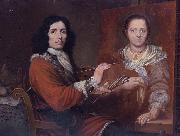 |
Giulio Quaglio
|
|
(1610-1658 or after) was an Italian painter of frescoes.
He was a follower of Tintoretto. He is known to have worked in Vienna, Salzburg, and Ljubljana. His son, Giulio the younger, was born in Como and established himself in the Friuli about the end of the 17th century. He is best known for frescoes at the chapel of the Monte di Piete, at Udine. He died in 1720. They are both part of a large family of artists and architects from the town of Laino, between Lake Garda and Lake Como, and which included Giuseppe Quaglio and his sons Lorenzo the younger, Simon, and Domenico; Lorenzo Quaglio the elder; and Giovanni Maria Quaglio and his son.
|
|
 |
Giulio Cesare Procaccini
|
|
1574-1625 Italian Giulio Cesare Procaccini Gallery
Giulio Cesare Procaccini (1574-1625) was an Italian painter and sculptor of the early Baroque era in Milan.
Born in Bologna he was son of the Mannerist painter Ercole Procaccini the Elder and brother of Camillo Procaccini and Carlo Antonio Procaccini. The family moved to Milan around 1585 with the help of the rich art collector Pirro Visconti.
He began as a sculptor in the Cathedral and in the Milanese church of Santa Maria presso San Celso. In 1610 he painted six of the Quadroni, large canvases celebrating Saint Charles Borromeo .
Among his many altarpieces are the Circumcision now in Galleria Estense, Modena (c.1616) and the Last Supper (1616) for Convent associated with the Basilica della Santissima Annunziata del Vastato in Genoa. He also painted the Scourging of Christ.
He worked with Giovanni Battista Crespi (il Cerano) and Pier Francesco Mazzucchelli (il Morazzone) following the directions of Cardinal Federico Borromeo, patron of the arts and cousin of Charles Borromeo. He also painted small religious canvases for rich families, in Milan and in Genoa, where he saw the works of Rubens.
His style shows the influence of Bolognese Mannerism and Venetian colorism and marks the beginning of the Baroque.
|
|
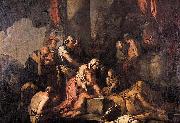 |
Giulio Carpioni
|
|
(1613 - 29 January 1678) was an Italian painter and etcher of the early Baroque era.
Born probably in Venice, Carpioni studied under Alessandro Varotari (il Padovanino) and was also influenced by the work of Simone Cantarini, Carlo Saraceni and Jean Leclerc. He came into contact with Lombard art after a brief visit to Bergamo in 1631. In 1638 he settled in Vicenza and executed most of his work there.
He painted history and bacchanals, and also sacred subjects of a small size, many of which are to be seen in the churches in the Venetian states. Paintings by him may be seen in the Galleries of Augsburg, Dresden, Vienna, Modena, and Florence. He was also an etcher; his best plates being St. Anthony of Padua, Christ on the Mount of Olives, The Virgin reading, and The Virgin with Rosary. He died at Verona. Carlo Carpioni, his son, was also a painter.
Among his important works are the Apotheosis of the Dolfin family (1647) and the Allegory of the Grimani Family (1651), and altarpiece of Sant'Antonio da Padova, a Virgin and two saints, and a Triumph of Silenus in the Gallerie dell Accademia of Venice. He painted a series of canvases for the Oratory of San Nicola da Tolentino in Vicenza.
|
|
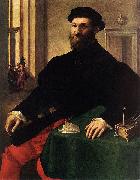 |
Giulio Campi
|
|
(1500 - 5 March 1572) was an Italian painter and architect. His brothers Vincenzo Campi and Antonio Campi were also renowned painters.
The eldest of a family prominent painters, Campi was born at Cremona. His father Galeazzo (1475-1536) taught him the first lessons in art.
In 1522, in Mantua, he studied painting, architecture, and modelling under Giulio Romano. He visited Rome, became an ardent student of the antique, and like Bernardino e distantly related to him e he combined a Lombard and Roman traditions. He collaborated on some works with Camillo Boccaccino, the son of Boccaccio Boccaccino, with whom Campi may also have received training.
Campi is called the "Ludovico Carracci of Cremona" although he preceded the founder of the Eclectics. When but twenty-seven Giulio executed for the church of Sant' Abbondio his masterpiece, a Virgin and Child with Sts. Celsus and Nazarus, a decoration masterly in the freedom of its drawing and in the splendour of its colour. His numerous paintings are grandly and reverently conceived, freely drawn, vigorously coloured, lofty in style, and broadly handled. He was animated in all his work by a deep piety. Numerous of his fresco works are housed in churches of Cremona, Mantua, Milan and in the church of Saint Margaret's, in his native town. Among his chief works are the Descent from the Cross (S. Sigismondo) at Cremona, and the frescoes in the dome of S. Girolamo at Mantua. An altar-piece in S. Sigismondo and his Labours of Hercules were engraved by the celebrated Ghiso, il Mantovano.
He died in Cremona in 1572.
|
|
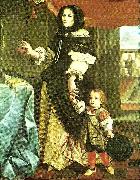 |
gittadini
|
|
In Venezia, 1585, in duodecimo. Cittadini was born in Rome, and died at Florence, 1622,
|
|
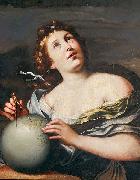 |
Girolamo Troppa
|
|
Girolamo Troppa (1637-1710) was an Italian painter of the Baroque. He was active in Rome. He was a follower of Carlo Maratti. He painted for the church of San Giacomo delle Penitenti, in competition with the son of Giovan Francesco Romanelli. He died in 1710.
|
|
|
|
|
|
 |
Girolamo Nerli
|
|
1860-1926,was an Italian painter who worked and travelled in Australia and New Zealand in the late 19th century influencing Charles Conder and Frances Hodgkins and helping to move Australian and New Zealand art in new directions. His portrait of Robert Louis Stevenson in the Scottish National Portrait Gallery Edinburgh, is usually considered the most searching portrayal of the writer. Born in Siena in Italy to an Italian aristocrat, Ferdinando Pieri Nerli, his full name was Girolamo Pieri Pecci Ballati Nerli. The fourth of six children he was not a 'Marchese' as he was sometimes styled, or a 'Count', but a 'patrizio di Siena', a minor distinction marking the great antiquity of his family. His father married Henrietta Medwin, an Englishwoman. Her father Thomas Medwin was a minor literary figure in Byron's circle, the author of Journal of the Conversations of Lord Byron and of The Life of Percy Bysshe Shelley; Medwin was a distant relation of Shelley. Girolamo studied art in Florence under Antonio Ciseri and Giovanni Muzzioli and was a younger member of the Italian Macchiaioli school, the 'patch painters', an Italian movement anticipating French Impressionism. He went to Australia in 1885 spending time in Melbourne and Sydney where he was an associate of Tom Roberts and Arthur Streeton and an influence on Charles Conder at the time of the Heidelberg School. Nerli's role in that movement has been disputed but his presence and influence are undeniable. was an Italian painter who worked and travelled in Australia and New Zealand in the late 19th century influencing Charles Conder and Frances Hodgkins and helping to move Australian and New Zealand art in new directions. His portrait of Robert Louis Stevenson in the Scottish National Portrait Gallery Edinburgh, is usually considered the most searching portrayal of the writer. Born in Siena in Italy to an Italian aristocrat, Ferdinando Pieri Nerli, his full name was Girolamo Pieri Pecci Ballati Nerli. The fourth of six children he was not a 'Marchese' as he was sometimes styled, or a 'Count', but a 'patrizio di Siena', a minor distinction marking the great antiquity of his family. His father married Henrietta Medwin, an Englishwoman. Her father Thomas Medwin was a minor literary figure in Byron's circle, the author of Journal of the Conversations of Lord Byron and of The Life of Percy Bysshe Shelley; Medwin was a distant relation of Shelley. Girolamo studied art in Florence under Antonio Ciseri and Giovanni Muzzioli and was a younger member of the Italian Macchiaioli school, the 'patch painters', an Italian movement anticipating French Impressionism. He went to Australia in 1885 spending time in Melbourne and Sydney where he was an associate of Tom Roberts and Arthur Streeton and an influence on Charles Conder at the time of the Heidelberg School. Nerli's role in that movement has been disputed but his presence and influence are undeniable.
|
|
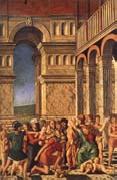 |
Girolamo Mocetto
|
|
Italian Painter, ca.1470-1531,Italian engraver, painter and designer of stained glass. He was born into a family of glass painters, and, although there is no documentary evidence that he worked outside Venice, his early paintings and engravings show the influence of Domenico Morone and of Mantegna and his circle, which would suggest that Mocetto's training may not have been exclusively Venetian. His artistic evolution is most clearly seen in a comparison of early works still close to Morone, such as a series of three engravings of the Battle between Israel and the Amalekites (see Hind, nos 719-20) or the painting of the Battle (Pavia, Pin. Malaspina), to works of a few years later, such as the two small paintings of the Massacre of the Innocents (London, N.G.; see fig.) and the engravings of Pagan Sacrifices (H 726-7), the Metamorphosis of Amymone (H 728) and the Calumny of Apelles (H. 727), all datable to c. 1500. In the later works, whole passages or motifs are copied or adapted from drawings and engravings by Mantegna. Mocetto may have had direct contact with the court of Mantua (the Metamorphosis of Amymone is an allegory of the city of Mantua); two engravings dating from the first years of the 16th century, St John the Baptist (H 724) and Judith with the Head of Holofernes (H 725),
|
|
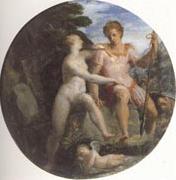 |
Girolamo Macchietti
|
|
Italian Painter , Firenze1535-1592
was an Italian painter active in Florence, working in a Mannerist style. He was a pupil of Michele di Ridolfi. During 1556-62, worked as an assistant to Giorgio Vasari in the decoration of the Palazzo Vecchio, where he worked with Mirabello Cavalori. He participated in the Vasari-directed decoration of the Studiolo of Francesco I with two canvases, one relating a Jason and Medea (1570) and the other a Baths of Pozzuoli (1572). He also painted an altarpiece on the Martyrdom of Saint Lawrence for Santa Maria Novella. In 1577, he completed a Gloria di San Lorenzo for Empoli Cathedral. He traveled to Rome and spent two years in Spain (1587-1589).
|
|
|
|
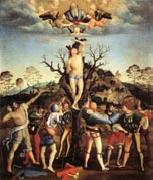 |
Girolamo Genga
|
|
Italian Painter and Architect , 1476-ca.1551
was an Italian painter and architect of the late Renaissance, Mannerist Genga was born near Urbino. According mainly to Giorgio Vasari's biography, by age thirteen Genga had gained an apprenticeship in Orvieto under Luca Signorelli. He was afterwards for three years with Pietro Perugino, in company with Raphael. He next worked in Florence and Siena (where he decorated the Petrucci palace c. 1508), along with Timoteo della Vite; and in the latter city he painted various compositions for Pandolfo Petrucci, a leading local statesman. Returning to Urbino, he was employed by Duke Guidobaldo da Montefeltro in the decorations of his palace, and showed extraordinary aptitude for theatrical adornments. He is recorded as having help design the decorations for the Duke's funeral in 1508. From Urbino, he went to Rome and painted church of Santa Caterina da Siena one of his masterpieces: The Resurrection. Francesco Maria I della Rovere, duke of Urbino, recalled Genga, and commissioned him to execute works in connection with his marriage to Eleonora Gonzaga in 1522. This prince being soon afterwards expelled by Pope Leo X, Genga followed him to Mantua, whence he went for a time to Pesaro. The duke of Urbino was eventually restored to his dominions; he took Genga with him, and appointed him the ducal architect and decorator. He worked extensively on the Villa Imperiale on Mount Accio . Among his work in Urbino, was the scenography of plays,
|
|
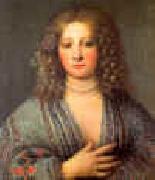 |
Girolamo Forabosco
|
|
1604-1679
Italian
Girolamo Forabosco Location
Italian painter. He was active in Padua and Venice, where he was enrolled in the Fraglia dei Pittori between 1634 and 1639 and paid taxes from 1640 to 1644. His early work, such as the portrait of the so-called Menichina (1624; Rome, Pal. Barberini), was influenced by that of Alessandro Varotari (Padovanino), who had revived the style of Titian. He also adopted compositional and formal schemes from Tiberio Tinelli, as in the Portrait of a Woman. The large canvas of the Miraculous Rescue (1646; Malamocco, S Maria Assunta), commissioned by Giovanni Ventura as an ex-voto for his escape from a shipwreck, shows Forabosco, unconstrained by the narrative and devotional character premises of the undertaking, creating a tender portrait group, distinguished by its spontaneity. The most striking quality of his work is its combination of physiognomic exactitude with free, fluid brushwork.
|
|
|
|
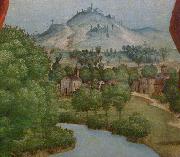 |
Girolamo dai Libri
|
|
(1474/1475 - July 2, 1555) was an Italian illuminator of manuscripts and painter of altarpieces, working in an early-Renaissance style.
He was born and mainly active in Verona. His father was Francesco dai Libri, and was so named because he was an illuminator of books. Girolamo's works were noted by Giorgio Vasari. Girolamo was a pupil of Domenico Morone. Dai Libri painted his first altarpiece, a Deposition from the Cross for Santa Maria in Organo in Verona, at the age of sixteen.
|
|
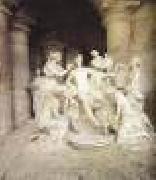 |
GIRARDON, Francois
|
|
French Baroque Era Sculptor, 1628-1715
François Girardon was born at Troyes on March 17, 1628. He studied in Rome for an undetermined period of time between 1645 and 1650. He then studied at the Royal Academy in Paris and was admitted to the academy as a member in 1657. Much of Girardon's most important work was executed for King Louis XIV and consisted of major commissions for the palace and gardens of Versailles. One of Girardon's most famous productions is Apollo and the Nymphs of Thetis in Versailles (1666-1672), originally designed for a grotto there. This elaborate project of seven separate marble statues depicts the god Apollo surrounded by nymphs, and it exemplifies with exceptional clarity the French interpretation of the baroque style in sculpture, an interpretation that rejected the fluid, dramatic, and emotional Italian baroque in favor of a cooler, more sober approach based upon the sculpture of antiquity. The Apollo group is filled with references to Hellenistic and Roman sculpture, and while Girardon was working on the commission he made a second trip to Rome for inspiration from antique sources. The ancient world, however, had never attempted to assemble several large pieces of free-standing sculpture into one unified composition, and in solving this problem Girardon had recourse to the paintings of Nicolas Poussin, the great French baroque classicist. The classicism of the Apollo group conformed fully to the official style of the French Academy and the personal taste of Louis XIV, but the composition has many baroque elements. The vigor and variety in the movement of the figures, the rich textural contrasts, the grand scale of the project, and the dramatic use of space are all stylistic qualities that firmly link the work to the international baroque style. One of Girardon's most important works is the tomb of Cardinal Richelieu in the church of the Sorbonne, Paris (1675-1677). This monument shows the dying prelate in a semireclining position, his vestments falling in broad curves that are echoed in the draperies of the allegorical figures at the head and foot of the tomb. As originally placed in the church, the monument was freestanding so that the spectator was compelled to enter into the action of the work - a typical baroque compositional device. Girardon's most significant late work was a majestic bronze equestrian statue of Louis XIV (1683-1692) executed for the Place Vendôme in Paris and based upon the famous Roman equestrian monument of the emperor Marcus Aurelius.
|
|
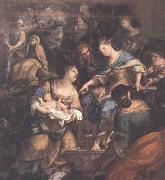 |
Giovanni Tuccari
|
|
Giovanni Tuccari (1667-1743) was an Italian painter during the Baroque period, active in Sicily.
Tuccari was born in Messina. He was the son and pupil of Antonio Tuccari, an obscure painter. He excelled as a battle painter. He died of the plague. He was responsible for the frescos in the Church of San Benedetto in Catania. Other examples of his work include four octagonal paintings in the sanctuary of the Church of S. Antonio, at Castiglione di Sicilia, and La Pinacoteca Zelantea gallery in Acireale.
|
|
|
|
|
|
|
|
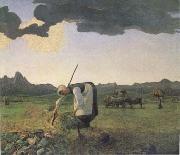 |
Giovanni Segantini
|
|
Italian Art Nouveau Painter, 1858-1899
Italian painter and draughtsman. An exponent of DIVISIONISM, he was the only Italian painter of the late 19th century to have enjoyed an unbroken international reputation, especially in Germany and Austria.
|
|
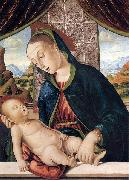 |
Giovanni Santi
|
|
(c. 1435 - 1 August 1494) was an Italian painter and decorator, father of Raphael. He was born at Colbordolo in the Duchy of Urbino. He was a petty merchant for a time; he then studied under Piero della Francesca. He was influenced by Fiorenzo di Lorenzo, and seems to have been an assistant and friend of Melozzo da Forle. He was court painter to the Duke of Urbino and painted several altarpieces, two now in the Berlin Museum, a Madonna in the church of San Francesco in Urbino, one at Santa Croce on Fano, one in the National Gallery at London, and another in the gallery at Urbino; an Annunciation at the Brera in Milan; a resurrected Christ in the Museum of Fine Arts, Budapest; and a Jerome in the Lateran. He died in Urbino.
|
|
|
|
|
|
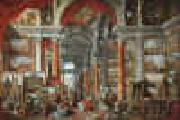 |
Giovanni Paolo Pannini
|
|
1691-1765
Italian
Giovanni Paolo Pannini Galleries
Italian painter. After gaining fame for his fresco painting, he specialized in Roman topography and became the foremost artist in that field in the 18th century. His real and imaginary views of ancient Roman ruins embody precise observation and tender nostalgia and combine elements of late classical Baroque art with incipient Romanticism. His work was popular both with tourists and his peers: he was admitted to the Acad??mie Française in 1732 and became its professor of perspective.
|
|
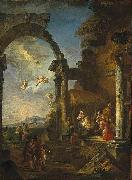 |
Giovanni Paolo Panini
|
|
17 June 1691 - 21 October 1765) was an Italian painter and architect, mainly known as one of the vedutisti .
As a young man, Panini trained in his native town of Piacenza, under Giuseppe Natali and Andrea Galluzzi, and later the stage designer Francesco Galli-Bibiena. In 1711, he moved to Rome, where he studied drawing with Benedetto Luti and became famous as a decorator of palaces, including the Villa Patrizi (1719-1725), the Palazzo de Carolis (1720), and the Seminario Romano (1721-1722). In 1719, Panini was admitted to the Congregazione dei Virtuosi al Pantheon. He taught in Rome at the Accademia di San Luca and the Academie de France, where he influenced Jean-Honore Fragonard. In 1754, he served as the principal of the Accademia di San Luca. Panini died in Rome on 21 October 1765
As a painter, Panini is best known for his vistas of Rome, in which he took a particular interest in the city's antiquities. Among his most famous works are the interior of the Pantheon, and his vedute paintings of picture galleries containing views of Rome. Most of his works, specially those of ruins have a substantial fanciful and unreal embellishment characteristic of capriccio themes.
|
|
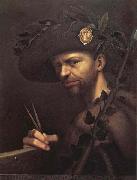 |
Giovanni Paolo Lomazzo
|
|
1538 - 1600
was an Italian painter, belonging to the second generation that produced Mannerism in Italian art and architecture. Gian Paolo Lomazzo was born in Milan from a family emigrated from the town of Lomazzo. His early training was with Giovan Battista della Cerva in Milan. He painted a large Allegory of the Lenten Feast for San Agostino in Piacenza (1567). He also painted an elaborate dome with Glory of Angels for the Capella Foppa in San Marco in Milan. He also painted the Fall of Simon Magus in the wall of the chapel. Lomazzo became blind in 1571, and turning to writing, produced two complex treatises that are milestones in the development of art criticism. His first work, Trattato dell'arte della pittura, scoltura et architettura (1584) is in part a guide to contemporary concepts of decorum, which the Renaissance inherited in part from Antiquity, which controlled a consonance between the functions of interiors and the kinds of painted and sculpted decors that would be suitable; Lespingola offered a systematic codification of esthetics that typifies the increasingly formalized and academic approaches typical of the later sixteenth century. His less practical and more metaphysical Idea del tempio della pittura ("The ideal temple of painting", 1590) offers a description along the lines of the "four temperaments" theory of the human nature and personality,
|
|
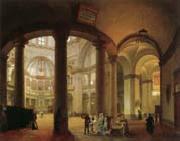 |
Giovanni Migliara
|
|
Italian 1785-1837
He began his career as a scene painter with Gaspare Galiari (1761-1823) in Milan, working at the Teatro Carcano in 1804 and at La Scala from 1805 to 1809. Owing to illness, after 1810 he turned to small-scale works in watercolour or oil using various supports, including silk and ivory. At this date Milanese painting was dominated by Andrea Appiani and Luigi Sabatelli, both leading Neo-classical artists. However, Migliara remained aloof from this dominant movement and instead drew on medieval and historical subjects with Romantic undertones. His precise, jewel-like technique and choice of subject-matter found favour with aristocratic patrons in Milan. His figures are generally stilted and burdened by their costumes, though the crowd in Sacking of Minister Prina's House (1814; Milan, Gal. A. Mod.) is depicted with unusual fluency. In 1822 Migliara was appointed Professor of Perspective at the Accademia di Belle Arti, Milan, and in 1833 he was nominated painter to the court of Charles-Albert, King of Sardinia (reg 1831-49). More typical of his historical scenes is Entrance to the Castle of Plessis de la Tour (Turin, Gal. Civ. A. Mod.), which was exhibited at the Brera in 1833. He also produced many topographically precise pictures of church interiors in which he combined his training as a scene painter with his knowledge of intaglio techniques.
|
|
|
|
|
|
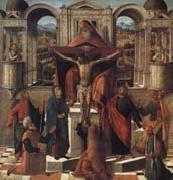 |
Giovanni Mansueti
|
|
Italian Early Renaissance Painter, active 1484-ca.1526, was an Italian painter. Also known as Giovanni Mansueti. Known by a few paintings. Little is known of his biography. He was active in Venice from 1485 to 1526. Pupil of Gentile Bellini and worked in the antique style in the Miracles of the Cross painted in 1494- c. 1502 for the Scuola di san Giovanni Evangelista and now in the Gallerie dell'Accademia. In style he resembles Cima da Conegliano and Vittore Carpaccio. One of his paintings resides in a church near Bagni di Luca, Italy.
|
|
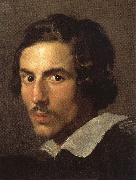 |
Giovanni Lorenzo Bernini
|
|
Italian Baroque sculptor, painter and architect.1598-1680
was a pre-eminent Baroque sculptor and architect of 17th Century Rome. Bernini was born in Naples to a Mannerist sculptor, Pietro Bernini, originally from Florence. At the age of seven he accompanied his father to Rome, where his father was involved in several high profile projects. There as a boy, his skill was soon noticed by the painter Annibale Carracci and by Pope Paul V, and Bernini gained the patronage exclusively under Cardinal Scipione Borghese, the pope's nephew.
|
|
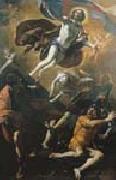 |
Giovanni Lanfranco
|
|
(26 January 1582 - 30 November 1647) was an Italian painter of the Baroque period.
Giovanni Gaspare Lanfranco was born in Parma, the third son of Stefano and Cornelia Lanfranchi, and was placed as a page in the household of Count Orazio Scotti His talent for drawing allowed him to begin an apprenticeship with the Bolognese artist Agostino Carracci, brother of Annibale Carracci, working alongside fellow Parmese Sisto Badalocchio in the local Farnese palaces. When Agostino died in 1602, both young artists moved to Annibale's large and prominent Roman workshop, which was then involved in working on the Galleria Farnese in the Palazzo Farnese gallery ceiling.
|
|
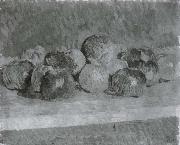 |
Giovanni Giacometti
|
|
Swiss Painter, 1868-1933,was a Swiss painter. He was the father of the artists Alberto and Diego Giacometti and the architect Bruno Giacometti.
|
|
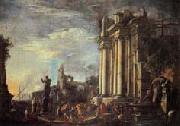 |
Giovanni Ghisolfi
|
|
Italian Painter ,
ca.1623-1683
He first trained with his uncle, Antonio Volpino. In 1650, together with his friend Antonio Busca, he travelled to Rome, where he studied the great compositions of Pietro da Cortona and for some time frequented the studio of Salvator Rosa. In 1661 he returned to Lombardy and worked at the Certosa di Pavia, decorating a whole chapel with frescoes showing Legends of St Benedict (in situ), and later providing a canvas of St Bruno, which is now in the Certosa library. In the background of this picture Ghisolfi painted a sloping landscape in a style very close to that of Pietro da Cortona. In the following years he evidently established a reputation for landscape paintings with architecture and ancient ruins. In 1664 he was called to Vicenza to execute, in the Palazzo Trissino Baston and the Palazzo Giustiniani Baggio, an extensive series of decorative landscape frescoes (partially destr.; known through photographs). Numerous preparatory drawings for these exist (Haarlem, Teylers Mus.; Windsor Castle, Berks, Royal Col.). In the same period Ghisolfi collaborated with Antonio Busca on a series of decorative frescoes in the gallery of Palazzo Borromeo Arese at Cesano Maderno, near Milan, and later, with Federico Bianchi, in the Villa Litta Modigliani (1680) at Varese. Both these works have been gravely damaged by decay and later repaintings.
|
|
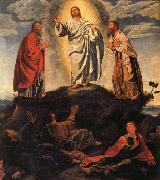 |
Giovanni Gerolamo Savoldo
|
|
Italian Mannerist Painter , c. 1480 - aft.1548
was an Italian High Renaissance painter. Savoldo was born in Brescia, but little is known about his early years. Some sources claim he was known as Girolamo Bresciano. By 1506 he was in Parma, and by 1508, he had joined the Florentine painter??s guild. In this period he finished the Rest at the Flight from Egypt (Augsburg), the Elijah Harassed by a Crow (National Gallery of Art, Washington), and a Deposition. In 1515 he painted the Portrait of a Clad Warrior, wrongly identified with Gaston de Foix. Also from the same period his the Temptings of St. Anthony, which appears to show the influence of the Flemish Hieronymus Bosch. The works was appreciated by the commissioners from Venice, where Savoldo relocated before 1520. On June 15, 1524 he signed a contract for an altarpiece for the church of San Domenico in Pesaro (now in the Brera, Milan). In 1527, he completed a St. Hieronymus for the Brescian family Averoldi, probably the one at National Gallery of London. From the 1530s dates a Nativity at the National Gallery in Washington DC, which seems influenced by the lambent contemporary, Correggio painting on the same topic. In 1533 Savoldo painted a Madonna with Four Saints in the church of Santa Maria in Organo, while in 1537-1538 he executed the altarpiece for the main altar of Santa Croce, Brescia.
|
|
|
|
 |
Giovanni Fattori
|
|
Italian Realist Painter , 1825-1908
was an Italian artist, one of the leaders of the group known as the Macchiaioli. He was initially a painter of historical themes and military subjects. In his middle years, inspired by the Barbizon school, he became one of the leading Italian plein-airists, painting landscapes, rural scenes, and scenes of military life. After 1884, he devoted much energy to etching.
|
|
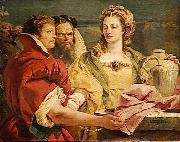 |
Giovanni Domenico Tiepolo
|
|
(August 30, 1727 - March 3, 1804) was a Venetian painter and printmaker in etching. He was the son of artist Giovanni Battista Tiepolo and elder brother of Lorenzo Baldissera Tiepolo..
Domenico was born in Venice, studied under his father, and by the age of 13 was the chief assistant to him. He was one of the many assistants, including Lorenzo, that transferred the designs of his father (executed in the 'oil sketch' invented by the same). By the age of 20, he was producing his own work for commissioners.
He assisted his father in Werzburg 1751-3, decorating the famous stairwell fresco, in Vicenza at the Villa Valmarana in 1757, and in Madrid at the palace of Charles III from 1762-70.
|
|
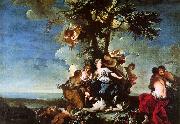 |
Giovanni Domenico Ferretti
|
|
1692-1768 Italian Giovanni Domenico Ferretti Location Italian painter. He was the son of the goldsmith Antonio di Giovanni da Imola and Margherita di Domenico Gori. His mother family, which included her brother, the antiquarian ANTONIO FRANCESCO GORI, was extremely influential in Florence and proved very important for Ferretti. In the first years of his life he lived in Imola, where he was sent to study (1708) with the local painter Francesco Chiusuri. After the family moved to Florence, Ferretti was taught there by Tommaso Redi and Sebastiano Galeotti. Later he spent five years in Bologna, an important centre for the practice and teaching of academic painting, where, in the workshop of Felice Torelli, his work acquired its characteristic style.
|
|
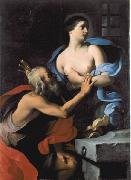 |
Giovanni Domenico Cerrini
|
|
(1609-1681), also called Gian Domenico Cerrini or il Cavalier Perugino, was an Italian painter of the Baroque period, active mainly in Rome and influenced in large part by painter of the Bolognese School.
Born in Perugia, Cerrini initially apprenticed under Giovanni Antonio Scaramuccia, then in 1638 moved into the Roman studio of Guido Reni, but strongly influenced by Lanfranco, Guercino, Domenichino, and Andrea Sacchi. He was patronized by the family of Cardinal Bernardino Spada. Cardinal Giulio Rospigliosi gave him the commission to decorate the cupola of Santa Maria della Vittoria (1654-5). His style has the monumental clarity of Domenichino, but somewhat sapped of vitality.
Paintings of his can be found in many of the churches of Rome, where he died, including Santa Maria in Traspontina, San Carlino alle Quattro Fontane, Chiesa Nuova, San Carlo ai Catinari, Santissimo Sudario dei Piemontesi, Sant??Isidoro, as well as in Galleria Colonna, Palazzo Spada, and the Palazzo Corsini art gallery.
|
|
|
|
|
|
|
|
|
|
|
| Wholesale China Oil Painting Wholesale Oil Painting China Xiamen Portrait Reproduction on canvas Chinese Oil Painting Wholesale USA Oil Painting |
|
|
|
|
|